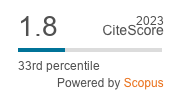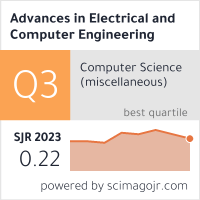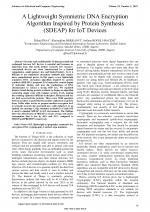| 1/2025 - 9 | View TOC | « Previous Article | Next Article » |
A Lightweight Symmetric DNA Encryption Algorithm Inspired by Protein Synthesis (SDEAP) for IoT DevicesDJAA, D. |
| Extra paper information in |
| Click to see author's profile in |
| Download PDF |
Author keywords
IoT, lightweight cryptography, symmetric key encryption, DNA cryptography, Contiki-Cooja simulator
References keywords
cryptography(13), systems(11), internet(9), cryptographic(8), security(7), computing(7), encryption(6), sensor(5), science(5), information(5)
Blue keywords are present in both the references section and the paper title.
About this article
Date of Publication: 2025-02-28
Volume 25, Issue 1, Year 2025, On page(s): 79 - 90
ISSN: 1582-7445, e-ISSN: 1844-7600
Digital Object Identifier: 10.4316/AECE.2025.01009
SCOPUS ID: 86000301418
Abstract
Security and confidentiality of data generated and exchanged between IoT devices is essential and becomes an important issue that needs further research. IoT resource-constrained devices are often characterized by a limited computation, small memory size and limited battery. So it is difficult to use traditional encryption methods that require more computational power. In this paper, a new lightweight symmetric DNA encryption algorithm inspired by protein synthesis (SDEAP) is proposed. It is inspired by central dogma of molecular biology and uses the randomness of DNA chromosomes to extract a strong OTP key. We exploited features found during protein synthesis to design an algorithm containing simple steps with complex security levels, making the resulting ciphertext difficult to decipher. Plaintext and key are both converted into proteins. Then a new XOR operation between proteins is performed to produce ciphertext in protein form. Unlike other works we propose another encryption level to transmit securely the generated keys with ciphertext in an optimal size message. Cooja simulator available in Contiki OS is used to simulate SDEAP in IoT environment. The findings show the effectiveness of SDEAP in terms of time and power consumption that is less by 60% and 93%, compared to SIMON and PRESENT respectively. |
| References | | | Cited By «-- Click to see who has cited this paper |
| [1] S. Medileh, A. Laouid, E. M. B. Nagoudi, R. Euler, A. Bounceur, M. Hammoudeh, M. AlShaikh, A. Eleyan, O. A. Khashan, "A flexible encryption technique for the internet of things environment," AdHoc Network, vol. 106, pp. 102240, 2020. [CrossRef] [Web of Science Times Cited 32] [SCOPUS Times Cited 48] [2] G. R. S. Qaid, N. S. Ebrahim, "A lightweight cryptographic algorithm based on DNA computing for IoT devices," Security and Communication Networks, vol. 2023, no. 1, pp. 9967129, 2023. [CrossRef] [3] J. M. Kissa, "Internet of Things (IoT): Growth, challenges, and security," In: Guide to Computer Network Security. Texts in Computer Science: Springer Cham, pp. 557-573, 2024. [CrossRef] [4] A. G. Forte, S. Cirani, G. Ferrari, "A distributed approach to energy-efficient data confidentiality in the Internet of Things," in Big Data-Enabled Internet of Things, IET Digital Library, pp. 75-92, 2019. [CrossRef] [SCOPUS Times Cited 1] [5] A. Khobzaoui, K. Benyahia, "DNA-based LSB steganography," International Journal of Security and Privacy in Pervasive Computing (IJSPPC), vol. 14, no. 1, pp. 1-9, 2022. [CrossRef] [6] S. Namasudra, "A secure cryptosystem using DNA cryptography and DNA steganography for the cloud-based IoT infrastructure," Computers and Electrical Engineering, vol. 104, pp. 108426, 2022. [CrossRef] [Web of Science Times Cited 29] [SCOPUS Times Cited 54] [7] M. Abu Alhija, N. Turab, A. Abuthawabeh, H. Abuowida, J. Al-Nabulsi, "DNA cryptographic approaches: State of art, opportunities, and cutting edge perspectives," Journal of Theoretical and Applied Information Technology, vol. 100, no. 18, pp. 5346-5358, 2022. [8] B. Al-Shargabi, A. Dar Assi, "A modified lightweight DNA-based cryptography method for internet of things devices," Expert Systems, vol. 40, no. 6, pp. e13270, 2023. [CrossRef] [Web of Science Times Cited 4] [SCOPUS Times Cited 8] [9] N. Bari, M. Wajid, M. Ali Shah, G. Ejaz, A. Q. Stanikzai, "Securing digital economies by implementing DNA cryptography with amino acid and one-time pad," In Hybrid Conference of Competitive Advantage in the Digital Economy (CADE), pp. 99-104, 2022. [CrossRef] [SCOPUS Times Cited 1] [10] T. Mahjabin, A. Olteanu, Y. Xiao, W. Han, T. Li, W. Sun, "A survey on DNA-based cryptography and steganography," IEEE Access, vol. 11, pp. 116423-116451, 2023. [CrossRef] [Web of Science Times Cited 6] [SCOPUS Times Cited 10] [11] R. Beaulieu, D. Shors, J. Smith, S. Treatman-Clark, B. Weeks, L. Wingers, "The SIMON and SPECK families of lightweight block ciphers," Cryptology ePrint Archive, 2013 [12] A. Bogdanov, L. R. Knudsen, G. Leander, C. Paar, A. Poschmann, M. J. B. Robshaw, Y. Seurin, C. Vikkelsoe, "PRESENT: An ultra-lightweight block cipher," In Proc. The 9th International Workshop on Cryptographic Hardware and Embedded Systems (CHES): Springer, Berlin, Heidelberg, vol. 4727, pp. 450-466, 2007. [CrossRef] [SCOPUS Times Cited 2286] [13] S. Dhawan, A. Saini, "Secure data transmission techniques based on DNA cryptography," International Journal of Emerging Technologies in Computational and Applied Sciences, vol. 2, no. 1, pp. 95-100, 2012 [14] L. Kari, "From micro-soft to bio-soft: Computing with DNA," In Proc. Biocomputing and Emergent Computation, pp.146-164, 1997 [15] E. R. Soni, E. V. Soni, E. S. K. Mathariya, "Innovative field of cryptography: DNA Cryptography," In Proc. The First International Conference on Information Technology Convergence and Services, pp. 161-179, 2012. [CrossRef] [16] J. D. Watson, F. H. C. Crick, "The structure of DNA," Cold Spring Harbor symposia on quantitative biology, vol. 18, pp. 123-131, 1953. [CrossRef] [SCOPUS Times Cited 592] [17] K. Mazhar, H. Waleej, "Cryptography using DNA nucleotides," International Journal of Computer Applications, vol. 168, no. 7, pp. 16-18, 2017. [CrossRef] [18] L. Pray, "Discovery of DNA structure and function: Watson and Crick," Nature Education, vol. 1, no. 1, pp. 100, 2008. [19] O. Tornea, "Contributions to DNA cryptography: applications to text and image secure transmission," Other, Universite Nice Sophia Antipolis, Universitatea tehnica Cluj-Napoca, Roumanie, 2013 [20] S. S. Nafea., M. K. Ibrahem,"Cryptographic algorithm based on DNA and RNA properties," International Journal of Advanced Research in Computer Engineering and Technology, vol. 7, no. 11, pp. 804-811, 2018 [21] E. S. Babu, C. N. Raju, M. H. M. K. Prasad, "Inspired pseudo biotic DNA based cryptographic mechanism against adaptive cryptographic attacks," International Journal of Network Security, vol. 18, no. 2, pp. 291-303, 2016 [22] A. E. El-Moursy, M. Elmogy, A. Atwan, "DNA-based cryptography: motivation, progress, challenges, and future," Journal of Software Engineering and Intelligent Systems, vol. 3, no. 1, pp. 67-82, 2018 [23] J. C. S. D. Anjos, B. R. Filho, J. F. Barros, R. B. Schemmer, C. Geyer, U. Matte, "Genetic mapping of diseases through big data techniques," In Proc. the 17th International Conference on Enterprise Information Systems - SciTePress, vol. 2, ICEIS, 2015, pp. 279-286, 2015. [CrossRef] [SCOPUS Times Cited 3] [24] L. M. Adleman, "Molecular computation of solutions to combinatorial problems," Science, vol. 266, no. 5187, pp. 1021-1024, 1994. [CrossRef] [Web of Science Times Cited 2935] [SCOPUS Times Cited 3742] [25] R. Binti Abu Bakar, J. Watada, "DNA computing and its applications: survey," In Proc., 2008 Eighth International Conference on Intelligent Systems Design and Applications, vol.2, no. 1, pp. 288-294, 2008. [CrossRef] [Web of Science Times Cited 25] [SCOPUS Times Cited 51] [26] T. Kumar, S. Namasudra, "Introduction to DNA computing," In: Perspective of DNA Computing in Computer Science: Elsevier, vol. 129, pp. 1-38, 2023. [CrossRef] [Web of Science Times Cited 5] [SCOPUS Times Cited 6] [27] K. Benyahia, M. Meftah, A. Latreche, "A bio-inspired algorithm for symmetric encryption," International Journal of Organizational and Collective Intelligence, vol. 10, no. 1, pp. 1-12, 2020. [CrossRef] [28] M. Poriye, S. Upadhyaya, "A DNA based framework for securing information using asymmetric encryption," Wireless Personal Communications, vol. 129, pp. 1717-1733, 2023. [CrossRef] [Web of Science Times Cited 1] [SCOPUS Times Cited 4] [29] P. Pavithran, S. Mathew, S. Namasudra, G. Srivastava, "A novel cryptosystem based on DNA cryptography, hyperchaotic systems and a randomly generated moore machine for cyber physical systems," Computer Communications, vol. 188, pp. 1-12, 2022. [CrossRef] [Web of Science Times Cited 20] [SCOPUS Times Cited 26] [30] S. Basu, M. Karuppiah, M. Nasipuri, A. K. Halder, N. Radhakrishnan, "Bio-inspired cryptosystem with DNA cryptography and neural networks," Journal of Systems Architecture, vol. 94, pp. 24-31, 2019. [CrossRef] [Web of Science Times Cited 23] [SCOPUS Times Cited 46] [31] R. Vaishali, S. Manohar Naik, "A DNA cryptosystem using Diffie-Hellman key exchange," SN Computer Science, vol. 5, no. 274, pp. 1-12, 2024. [CrossRef] [SCOPUS Times Cited 4] [32] P. T. Akkasaligar, S. Biradar, "Selective medical image encryption using DNA cryptography," Information Security Journal: A Global Perspective, vol. 29, no. 2, pp. 91-101, 2020. [CrossRef] [Web of Science Times Cited 79] [SCOPUS Times Cited 123] [33] D. Wei, M. Jiang, "A fast image encryption algorithm based on parallel compressive sensing and DNA sequence," Optik, vol. 238, pp. 166748, 2021. [CrossRef] [Web of Science Times Cited 63] [SCOPUS Times Cited 75] [34] A. Khobzaoui, K. Benyahia, B. Mansouri, S. Boukli-Hacene, "DNA-based cryptographic method for the Internet of Things," International Journal of Organizational and Collective Intelligence, vol. 12, no. 1, pp. 1-12, 2022. [CrossRef] [35] R. Ettiyan, V. Geetha, "A hybrid logistic DNA-based encryption system for securing the Internet of Things patient monitoring systems," Healthcare Analytics, vol. 3, pp. 100149, 2023. [CrossRef] [SCOPUS Times Cited 11] [36] T. Reusing, "Comparison of operating systems Tinyos and Contiki," Sens. Nodes Operation, Netw. Appli. (SN), vol. 7, 2012 [37] J. Schandy, L. Steinfeld, F. Silveira, "Average power consumption breakdown of wireless sensor network nodes using IPv6 over LLNs," In Proc. IEEE International Conference on Distributed Computing in Sensor Systems, pp. 242-247, 2015. [CrossRef] [Web of Science Times Cited 11] [SCOPUS Times Cited 18] [38] K. Shah, D. C. Jinwala, "Performance analysis of symmetric key ciphers in linear and grid based sensor networks," In Proc. 5th International Conference on Artificial Intelligence and Applications, pp. 53-68, 2018. [CrossRef] [39] M. Amirinasab Nasab, S. Shamshirband, A. T. Chronopoulos, A. Mosavi, N. Nabipour, "Energy-efficient method for wireless sensor networks low-power radio operation in Internet of Things," Electronics, vol. 9, no. 2, 2020. [CrossRef] [Web of Science Times Cited 36] [SCOPUS Times Cited 48] [40] TmoteTM sky: Low power wireless sensor module, Moteiv Corporation 2006, available at https://www.snm.ethz.ch/snmwiki/pub/uploads/Projects/tmote_sky_datasheet.pdf [41] W. Choi, L. Park, Y. Kim, J. Jeong, "Power consumption analysis of cryptographic algorithms," In Proc. The 7th International Conference on Mobile Internet Security (MobiSec'23), no. 42, 2023 Web of Science® Citations for all references: 3,269 TCR SCOPUS® Citations for all references: 7,157 TCR Web of Science® Average Citations per reference: 78 ACR SCOPUS® Average Citations per reference: 170 ACR TCR = Total Citations for References / ACR = Average Citations per Reference We introduced in 2010 - for the first time in scientific publishing, the term "References Weight", as a quantitative indication of the quality ... Read more Citations for references updated on 2025-06-05 03:51 in 199 seconds. Note1: Web of Science® is a registered trademark of Clarivate Analytics. Note2: SCOPUS® is a registered trademark of Elsevier B.V. Disclaimer: All queries to the respective databases were made by using the DOI record of every reference (where available). Due to technical problems beyond our control, the information is not always accurate. Please use the CrossRef link to visit the respective publisher site. |
Faculty of Electrical Engineering and Computer Science
Stefan cel Mare University of Suceava, Romania
All rights reserved: Advances in Electrical and Computer Engineering is a registered trademark of the Stefan cel Mare University of Suceava. No part of this publication may be reproduced, stored in a retrieval system, photocopied, recorded or archived, without the written permission from the Editor. When authors submit their papers for publication, they agree that the copyright for their article be transferred to the Faculty of Electrical Engineering and Computer Science, Stefan cel Mare University of Suceava, Romania, if and only if the articles are accepted for publication. The copyright covers the exclusive rights to reproduce and distribute the article, including reprints and translations.
Permission for other use: The copyright owner's consent does not extend to copying for general distribution, for promotion, for creating new works, or for resale. Specific written permission must be obtained from the Editor for such copying. Direct linking to files hosted on this website is strictly prohibited.
Disclaimer: Whilst every effort is made by the publishers and editorial board to see that no inaccurate or misleading data, opinions or statements appear in this journal, they wish to make it clear that all information and opinions formulated in the articles, as well as linguistic accuracy, are the sole responsibility of the author.



